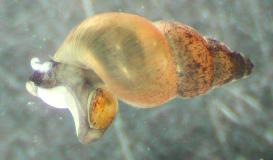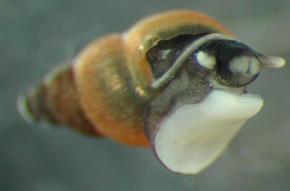Aquatic Invertebrates of Montana

Potamopyrgus antipodarum (Gray)



New Zealand Mudsnail in the Western USA
Because of the importance of this exotic species in Montana and surrounding states, a greatly expanded coverage is provided in cooperation with Dave Richards and Billie Kerans.
Recognition
This is an elongate hydrobiid mostly reaching about 5 mm in length (western USA record is 6 mm). It has the basic horn color of our pulmonates, but it has an operculum and the shell is much more solid. They are essentially all female- I have seen 3 males among countless females. Our other hydrobiids are smaller and less elongate and they have males well represented. Outside of Montana, identification is more complicated because more similar species are present.
Summary
A live-bearing parthenogenetic species with a solid shell and an operculum. All of these features are shared with another of our introduced species Melanoides tuberculata, which is much larger and limited to warm springs. It is reported to pass through the digestive tracks of fish alive and then give birth! Population levels may exceed 100,000 per square meter. It occupies wide microhabitat conditions and tolerates some pollution. Contrary to the name, it prefers more solid substrates than mud.
Distribution
This is an introduced species with an expanding distribution in the Missouri, Yellowstone, and Bighorn Rivers. It is not yet known in Montana west of divide so lets keep it that way! In Montana this species was first discovered in the Madison River above Hebgen Reservoir in 1995. However, the very large population present at that time indicataes that the introduction was a few years earlier. It is a native of New Zealand, but long established in Australia and Europe. This species has been known in North America since 1987 in the Snake River between Shoshone Falls and the C.J. Strike Dam.
Taxonomy
Also known as Potamopyrgus jenkinsi (Smith)
20 APR 1996, updated on 15 FEB 2003 D.L. Gustafson
AIM home page
dlg@rivers.oscs.montana.edu
